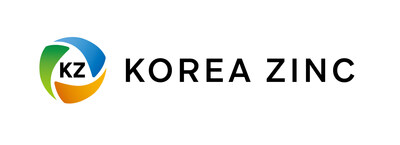Korea Zinc Solidifies Critical Role in U.S.-Korea Economic Security Amid Chinese Export Controls as the World's No.1 Indium Producer
SEOUL, South Korea, Feb. 14, 2025 /PRNewswire/ -- Korea Zinc (KRX:010130) is solidifying its unique position as a key player in the global critical minerals supply chain, particularly in response to China's recent expansion of export controls. As the only domestic producer of three of the five restricted minerals, Korea Zinc plays a crucial role in ensuring stable supply in South Korea. Additionally, the company is also the world's largest producer of refined indium, taking up 29% of the supply to the U.S., further strengthening its position as a cornerstone of efforts to diversify supply chains.
On February 4, China's Ministry of Commerce and General Administration of Customs imposed export controls on five critical materials—tungsten, tellurium, bismuth, molybdenum, and indium—triggering global concerns. This move significantly expanded China's previous export restrictions on antimony, a key material for weapons and defense industries, which were implemented in September 2024 to protect their national security and interests.
In response, the South Korean government has launched an urgent assessment of how these restrictions will affect domestic industries. According to the Ministry of Trade, Industry, and Energy (MOTIE), China accounted for 85% of South Korea's tungsten imports and over 90% of its molybdenum imports in 2024, highlighting the urgent need to secure alternative suppliers.
Despite this, the impact of China's export controls on indium, bismuth, and tellurium is expected to be limited in South Korea, as domestic production and supply remain stable. Currently, Korea Zinc is the only company in South Korea producing these three critical materials, and its continued investment in technology and increased production capacity has ensured a steady supply.
Among these materials, indium stands out as one of Korea Zinc's flagship products, as the company is the world's largest producer of refined indium.
According to the Korea Mineral Information Service (KOMIS), global indium production and demand reached approximately 1,400 tons in 2023, with China accounting for 50% of global output. Chinese producers have been increasing their market dominance, and even before the recent export restrictions, supply disruptions from China had caused market price fluctuations. Due to intermittent supply constraints, the average price of indium rose to USD 317 per kilogram in 2024, and further price hikes and supply chain disruptions are expected following the latest export controls.
Companies that rely on these critical materials are now scrambling to secure sufficient supply, underscoring the growing importance of Korea Zinc's production and supply capabilities.
Korea Zinc recovers indium in ingot form by extracting trace amounts from zinc concentrates used in zinc smelting, as well as from secondary raw materials processed in its fuming facilities. By maximizing recovery efficiency, Korea Zinc produces approximately 150 tons of indium annually, accounting for around 11% of global demand.
Notably, Korea Zinc's indium is playing a key role in diversifying supply chains away from China.
The 2025 report from the United States Geological Survey (USGS) states that South Korea accounted for 29% of indium imports from the United States between 2020 and 2023, which refers to Korea Zinc being responsible for approximately 30% of the U.S. indium supply chain. With China's export controls, the share of indium imports from South Korea is expected to rise. As was the case with antimony, further discussions on exporting rare metals such as indium are expected between the United States and South Korea.
The main use of indium is in ITO (Indium-Tin-Oxide), which is a transparent conductive oxide used in all flat-panel displays and touchscreens. It is typically deposited as a thin film on display surfaces to convert electrical data into optical form. Recently, the price of indium has remained low due to the market slump caused by poor LCD TV sales; however, the demand has been increasing in the solar industry, as indium is a key material in thin-film solar cell systems.
Additionally, the widespread adoption of 5G technology has been fueling the increasing global demand for indium. Indium Phosphide (InP)-based substrates play a significant role in 5G optical communication networks. Indium phosphide lasers and receivers transmit data through optical fibers, reducing latency, minimizing signal loss, and increasing speed.
The advancement of artificial intelligence (AI) technology is expected to increase demand for indium phosphide-based semiconductor materials. According to a report by a U.S. semiconductor substrate manufacturer, sales of indium phosphide-based substrates in the second quarter of 2024 have risen by 67% compared to the same period last year, highlighting the growing importance of indium as AI technology continues to evolve.
A spokesperson from Korea Zinc stated, "Under the leadership of Chairman Yun B. Choi and CTO Lee Je-Joong, the current management team has focused on increasing the recovery rate of rare metals, including indium, through active technological investments, considering the strategic importance of rare metals and key minerals. The spokesperson also added, "as a critical player in the national infrastructure industry, Korea Zinc plans to further strengthen its role as a key supply chain both domestically and internationally, contributing to the national economy and security, while helping to overcome China's export controls."
![]() View original content to download multimedia:https://www.prnewswire.com/news-releases/korea-zinc-solidifies-critical-role-in-us-korea-economic-security-amid-chinese-export-controls-as-the-worlds-no1-indium-producer-302376921.html
View original content to download multimedia:https://www.prnewswire.com/news-releases/korea-zinc-solidifies-critical-role-in-us-korea-economic-security-amid-chinese-export-controls-as-the-worlds-no1-indium-producer-302376921.html
SOURCE Korea Zinc


